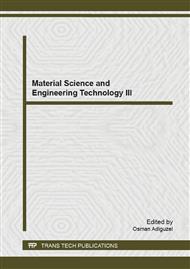p.431
p.438
p.442
p.446
p.453
p.459
p.463
p.467
p.471
Suppression of Thermocapillary Effect in Evaporating Thin Film of Micro Heat Pipes
Abstract:
This paper presents a theoretical study on the flow mechanism of different types of working fluids incorporated with Marangoni effect in a microelectronics cooling device. It is known that surface tension gradient effect or thermocapillary effect can be induced by temperature gradient which leads to the thermocapillary flow. By adding a small quantity of alcohol into the pure working fluid, the characteristics of surface tension can be altered without changing other thermo physical properties of the working fluid. A theoretical model is employed to focus on the suppression of thermocapillary effect in evaporating thin liquid film. The study reveals the fluid flow mechanism of a working fluid can be altered with thermocapillary effect. Thermal performance of microelectronics cooling devices can also be enhanced by utilizing aqueous solution as the working fluid.
Info:
Periodical:
Pages:
467-470
Citation:
Online since:
April 2015
Authors:
Price:
Сopyright:
© 2015 Trans Tech Publications Ltd. All Rights Reserved
Share:
Citation:


